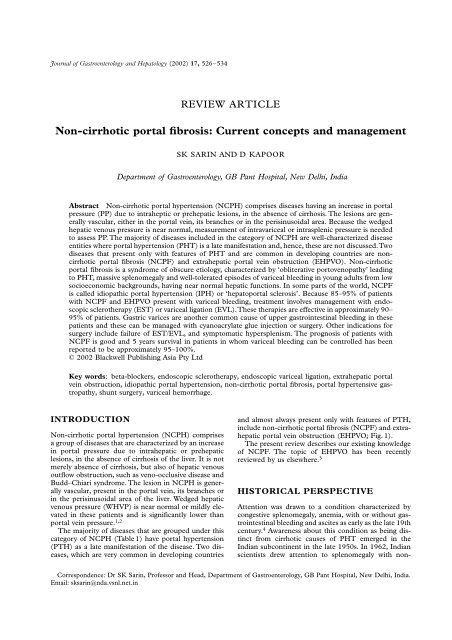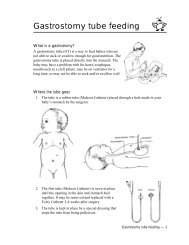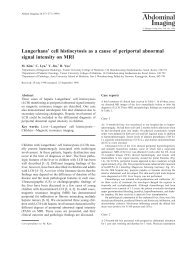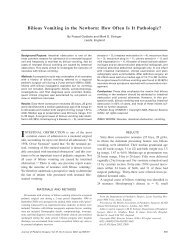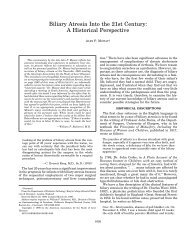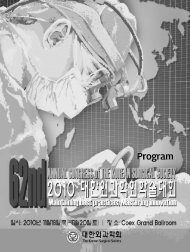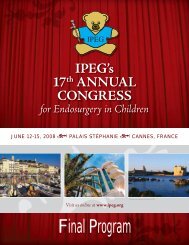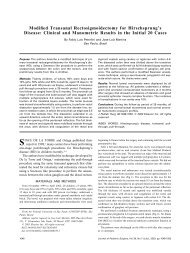Non-cirrhotic portal fibrosis: Current concepts and ... - Biliaryatresia.org
Non-cirrhotic portal fibrosis: Current concepts and ... - Biliaryatresia.org
Non-cirrhotic portal fibrosis: Current concepts and ... - Biliaryatresia.org
Create successful ePaper yourself
Turn your PDF publications into a flip-book with our unique Google optimized e-Paper software.
<strong>Non</strong>-<strong>cirrhotic</strong> <strong>portal</strong> <strong>fibrosis</strong> 529Table 3 Histological findings in idiopathic <strong>portal</strong>hypertensionFrequency (%)Figure 2 A proposed hypothesis for the pathogenesis ofnon-<strong>cirrhotic</strong> <strong>portal</strong> <strong>fibrosis</strong> (NCPF) <strong>and</strong> extrahepatic <strong>portal</strong>vein obstruction (EHPVO). MPV, main <strong>portal</strong> vein; RES,reticuloendothelial system.Dense <strong>portal</strong> <strong>fibrosis</strong> <strong>and</strong> <strong>portal</strong> venous obliterationMild 48Moderate to severe 52Portal inflammation 47Irregular intimal thickening of75–100*<strong>portal</strong> veinsOrganizing thrombotic <strong>and</strong>/or20–100*recanalization of <strong>portal</strong> veinsNodular hyperplasia of the parenchyma 40Abnormal blood vessels in the lobules 75Intralobular fibrous septa 95Subcapsular atrophy 70Periductal <strong>fibrosis</strong> of interlobular bile50ductsModified from Nakunuma et al. 29 based on a study of 66patients with idiopathic <strong>portal</strong> hypertension.*100% abnormalities were observed only in autopsyspecimens.seen in 10–15% of cases, is confined to the liver surface.The <strong>portal</strong> vein <strong>and</strong> its branches are prominent <strong>and</strong>have sclerosed walls. Autopsy series commonly showthrombosis in the medium <strong>and</strong> small (diameter< 300 µm) <strong>portal</strong> vein branches. 23,24HistopathologyHistological changes in NCPF were aptly summarizedby Nayak <strong>and</strong> Ramalingaswamy as ‘obliterative portovenopathyof liver’. 28 Essentially, there is a marked butpatchy <strong>and</strong> segmental subendothelial thickening of thelarge <strong>and</strong> medium-sized branches of the <strong>portal</strong> vein.These changes are summarized in an excellent reviewby Nakanuma et al. (Table 3). 29 The intimal thickeningof intrahepatic <strong>portal</strong> venous channels, associated withobliteration of small <strong>portal</strong> venules <strong>and</strong> emergence ofnew aberrant <strong>portal</strong> channels, is quite characteristic ofNCPF. Evidence of previous phlebothrombosis is suggestedby the presence of old mural thrombi incorporatedin the wall, mural thickening of the extrahepatic<strong>portal</strong> vein <strong>and</strong> coexistence of lesions characteristic ofNCPF as well as EHPVO in the same patient.UltrastructureA widening of the space of Disse with haphazardlyarranged collagen b<strong>and</strong>s in the perisinusoidal spaceleading to capillarization of sinusoids may be seen.Whether these electron microscopic changes correlatewith the severity of PHT or occurrence of ascites, whichis seen in a small proportion of NCPF patients, has notbeen determined.Figure 3 The pathoanatomic sites of resistance to <strong>portal</strong>blood flow in patients with non-<strong>cirrhotic</strong> <strong>portal</strong> <strong>fibrosis</strong>(NCPF), namely presinusoidal <strong>and</strong> perisinusoidal, caused bythickening <strong>and</strong> obstruction to the medium-sized <strong>and</strong> smallbranches of <strong>portal</strong> veins <strong>and</strong> the collagenization of the space ofDisse, respectively.HEMODYNAMICSThe intrasplenic <strong>and</strong> <strong>portal</strong> vein pressures are markedlyelevated in patients with NCPF. The WHVP may benormal or slightly elevated in approximately halfthe patients. Two pathoanatomic sites of obstruction(Fig. 3) have been identified: a pressure gradientbetween the spleen (intrasplenic pressure; ISP) <strong>and</strong> theliver (intrahepatic pressure; IHP) <strong>and</strong> another betweenthe liver (IHP) <strong>and</strong> the WHVP (Fig. 4). 30 Variceal pressurehas also been studied in these patients <strong>and</strong> foundcomparable to that in <strong>cirrhotic</strong> PHT. 30,31 Splenic <strong>and</strong>
530 SK Sarin <strong>and</strong> D KapoorTable 4 Profile of non-<strong>cirrhotic</strong> <strong>portal</strong> <strong>fibrosis</strong> <strong>and</strong> extrahepatic<strong>portal</strong> vein obstruction patientsNCPF(n = 207)EHPVO(n = 236)Figure 4 Two pressure gradients, between the spleen <strong>and</strong>liver (intrasplenic pressure (ISP)−intrahepatic pressure (IHP))<strong>and</strong> between the liver <strong>and</strong> the wedged hepatic venous pressure(IHP−WHVP) are observed in patients with non-<strong>cirrhotic</strong><strong>portal</strong> <strong>fibrosis</strong> (NCPF). In effect, they represent presinusoidal<strong>and</strong> perisinusoidal resistance to <strong>portal</strong> blood flow.<strong>portal</strong> vein blood flow are known to be markedlyincreased in IPH patients from Japan, suggestive of ahyperdynamic circulatory state. Pulmonary hemodynamicsin patients with NCPF have also beenreported. 32 Two of 22 patients in that study had featuresof primary pulmonary hypertension (PPH). Pulmonaryangiography was reported normal in the single patientin whom it was performed.CLINICAL PROFILE<strong>Non</strong>-<strong>cirrhotic</strong> <strong>portal</strong> <strong>fibrosis</strong> is a disease of youngpatients coming from a low socioeconomic background.Most studies quote a slight male preponderance(male : female ratio 2 : 1). 13,14 The patients may presentwith one or more well-tolerated episodes of gastrointestinalhemorrhage, long-st<strong>and</strong>ing mass in the left upperquadrant (splenomegaly) <strong>and</strong> consequences of hypersplenism.Development of ascites, jaundice <strong>and</strong> hepaticencephalopathy is uncommon <strong>and</strong> are only seen after anepisode of gastrointestinal hemorrhage. Of all thecauses of PHT, a massive <strong>and</strong> disproportionately largespleen is most commonly seen in NCPF. It is notuncommon to see patients presenting with repeatedattacks of left upper quadrant pain due to perisplenitis<strong>and</strong> splenic infarction. 33 The clinical presentation ofNCPF is distinct from IPH in several regards (Table 2).Like cirrhosis, NCPF may also have odd presentations,such as glomerulonephritis 34,35 or hypoxemia. 36Over a 12-year period (1983–1995), we had seen2137 patients with PTH; 1133 bleeders <strong>and</strong> 1004 nonbleeders.<strong>Non</strong>-<strong>cirrhotic</strong> <strong>portal</strong> <strong>fibrosis</strong> comprised35.4% of all bleeders <strong>and</strong> 4.1% of non-bleeders. <strong>Non</strong><strong>cirrhotic</strong><strong>portal</strong> <strong>fibrosis</strong> was diagnosed in 207 patients,while EHPVO was diagnosed in 236 patients. The clinical<strong>and</strong> laboratory profiles of these patients are shown inTable 4.Mean age (years) 30.7 13.9Sex (males : females) 117 : 90 168 : 68Hematemesis/melena (%) 84.5 94.5Mass in LUQ (%) 13.5 3.5Ascites (transient) (%) 10 12.7Jaundice (%) – 12.7Liver functions tests Near normal Near normalEsophageal varices (%) 92 94Gastric varices (%) 22.3 40.7Portal gastropathyPresclerotherapy (%) 1.6 0.5Post-sclerotherapy (%) 17 15Portal biliopathy (%) 40 90Portal colopathy (%) 40 44Data are based on the experience at the GB Pant Hospital,New Delhi, India. 37NCPF, non-<strong>cirrhotic</strong> <strong>portal</strong> <strong>fibrosis</strong>; EHPVO, extrahepatic<strong>portal</strong> vein obstruction; LUQ, left upper quadrant.LABORATORY FEATURESTests of liver function are, by <strong>and</strong> large, normal inNCPF patients. These include semiquantitative testsof liver function, such as monoethylglycinexylidide(MEGX) extraction. 38 Biliary lipid composition is normalin NCPF patients. 39 The frequency of hepatitis B<strong>and</strong> C in non-transfused NCPF patients is approximately5 <strong>and</strong> 3%, respectively (SK Sarin, unpubl. obs.,2000); similar to the figures in the general population.Anemia is a common finding in the majority ofNCPF patients. This may be microcytic, hypochromic(due to gastrointestinal blood loss) or normocytic,normochromic (hypersplenism). Leukopenia (< 4000 /mm 3 ) <strong>and</strong> thrombocytopenia (< 50 000 /mm 3 ) may alsobe present. These changes are due, in part, to anincrease in plasma volume <strong>and</strong> splanchnic pooling ofthe blood. Bone marrow is hypercellular. While asymptomatichypersplenism is common, symptomatichypersplenism is rather rare in NCPF. 40 Coagulation<strong>and</strong> platelet function anomalies have been observed inNCPH patients (Table 5). 41 A state of mild compensateddisseminated intravascular coagulation secondaryto endotoxemia or portosystemic collaterals has beenreported in a fair proportion of these patients. 41,42Autonomic dysfunction is increasingly being recognizedin patients with cirrhosis. We have recentlyobserved these anomalies in EHPVO patients, possiblybecause these patients do have some degree of hepaticdysfunction. 43 However, autonomic dysfunction doesoccur even in patients with NCPF, with near-normalliver function, suggesting some contribution of PTHper se.
<strong>Non</strong>-<strong>cirrhotic</strong> <strong>portal</strong> <strong>fibrosis</strong> 531Table 5 Coagulation <strong>and</strong> platelet function in non-<strong>cirrhotic</strong> <strong>portal</strong> hypertension 39Parameter (normal range) NCPF (n = 18) EHPVO (n = 18)INR 1.8 ± 0.68* 1.7 ± 0.4*PTT (28–31 s) 29 ± 4.2 30 ± 4.2*Fibrinogen (250–350 mg%) 196 ± 57** 199 ± 61**Fibrinogen degradation products (< 8 µg/mL) < 8 > 8**Platelet aggregation (40–60%) 33 ± 16.5 22 ± 11.3**Platelet MDA (6–12 nmol/mL) 9.0 ± 3.6 9.6 ± 3.8*P < 0.05, **P
532 SK Sarin <strong>and</strong> D KapoorTable 7Differentiating features between extrahepatic <strong>portal</strong> vein obstruction, non-<strong>cirrhotic</strong> <strong>portal</strong> <strong>fibrosis</strong> <strong>and</strong> cirrhosis of liverParameter EHPVO NCPF CirrhosisMean age (years) 10 28 40Ascites Absent/transient after bleed Absent/transient after bleed + to +++Encephalopathy – – +Jaundice/signs of liver failure – – +Liver function tests Normal* Normal DerangedLiverGross Normal/small Normal, rarely irregular Shrunken, nodularMicroscopic Normal Normal/<strong>portal</strong> <strong>fibrosis</strong> Necrosis, regenerationSplenoportovenography/US Portal/splenic vein block Normal spleno<strong>portal</strong> axis,‘withered tree’ appearance,peri<strong>portal</strong> <strong>fibrosis</strong>*Occasional impairment may be observed.NCPF, non-<strong>cirrhotic</strong> <strong>portal</strong> <strong>fibrosis</strong>; EHPVO, extrahepatic <strong>portal</strong> vein obstruction; US, ultrasound.Dilated, patent <strong>portal</strong><strong>and</strong> splenic veinChild’s A cirrhosis may mimic NCPF, but tests ofliver function, viral serology <strong>and</strong> histology (lobular disarray,pseudolobule formation) can distinguish betweenthe two. Moreover, a disproportionately large spleenwith a dilated <strong>and</strong> thickened <strong>portal</strong> vein favors the diagnosisof NCPF.Tropical splenomegaly syndrome (TSS) is anothercondition sometimes seen in the tropics, which presentswith massive splenomegaly. However, PHT is uncommonin patients with TSS <strong>and</strong> the WHVP is within normallimits. 50 Moreover, elevated serum IgM levels <strong>and</strong>high malarial antibody titers are common in TSSpatients.Histologically, NCPF needs to be distinguished fromconditions like nodular regenerative hyperplasia, partialnodular transformation <strong>and</strong> incomplete septal cirrhosis.MANAGEMENTThe key management issues in patients with NCPF aregastrointestinal hemorrhage <strong>and</strong> hypersplenism. Foracutely bleeding patients, endoscopic variceal ligation(EVL) <strong>and</strong> endoscopic sclerotherapy (EST) are equallyefficacious (95% success in the control of an acutebleed). 51 Emergency shunt surgery is required in lessthan 5% of cases. 52 Selective shunts, like a distal lienorenalshunt, are preferred because they have a lowerincidence of post-shunt encephalopathy. The number ofsessions of sclerotherapy required for obliteration ofvarices is similar in patients with cirrhosis <strong>and</strong> NCPH. 53Variceal recurrence has been reported in approximately20% of cases, but recurrent bleed is quite uncommon(approximately 3%). 52,53 Prevention of rebleeding hasbeen reported in patients with schistosomiasis in an isolatedstudy using non-selective beta-blockers. 54 Thesedata have not been confirmed in NCPF patients. In ourrecently reported experience of primary prophylaxisusing beta-blockers or EVL, both modalities were foundto be comparable <strong>and</strong> efficacious, even in non-<strong>cirrhotic</strong>patients, although the number of NCPF patients ineach group was small. 55 Gastric varices are seen innearly one-quarter of NCPF patients, more often thanthat seen in <strong>cirrhotic</strong> patients. 56 These varices can oftenbe managed with cyanoacrylate glue injection <strong>and</strong> rarelyrequire surgical intervention. 57Interventional radiological procedures have beenreported to be effective in IPH patients. These includesplenic embolization, percutaneous transhepatic obliteration<strong>and</strong> transjugular intraheptic portosystemicshunt (TIPS) procedure. 58 We have also performed aTIPS in three NCPF patients with gastric varices <strong>and</strong>the shunt remained patent at 12 months postprocedure.Surgery has been reported to be an effective alternativeto endoscopic therapy, especially in patients whofail to respond to endoscopic therapy. 59 Surgery is alsoindicated for patients with symptomatic hypersplenism–spontaneous bleeding episodes or severe anemia requiringtransfusion or repeated splenic infarcts. In thosepatients who hail from far-flung areas or who desireone-time treatment, elective shunt surgery is a reasonableoption. The most important cause of death inNCPF or IPH patients is exsanguinating hemorrhage.Prophylactic devascularization has been advocated bycertain Japanese workers. 23Surgical mortality after emergency shunts is approximately10%. Shunt occlusion, overt chronic portosystemicencephalopathy <strong>and</strong> rebleeding after electiveshunt surgery are seen in approximately 10% ofpatients. 60,61 The morbidity <strong>and</strong> mortality after shuntsurgery <strong>and</strong> the limited expertise available to performthese procedures have restricted the use of surgery inthe management of patients with NCPF. Recently,development of membranoproliferative glomerulonephritis<strong>and</strong> other renal anomalies have been reportedfollowing shunt surgery in NCPF patients. 34PROGNOSISThe prognosis for patients with NCPF is excellent. Themortality from an acute bleed in NCPH is significantlylower than that observed in <strong>cirrhotic</strong> patients. 23 Aftersuccessful eradication of esophagogastric varices, a 2-<strong>and</strong> 5-year survival of nearly 100% has been observed in
<strong>Non</strong>-<strong>cirrhotic</strong> <strong>portal</strong> <strong>fibrosis</strong> 533these patients. If these patients are managed with selectiveshunt surgery, shunt occlusion <strong>and</strong> post-shuntencephalopathy may cause some morbidity, but dietarymanipulations (protein restriction) can ameliorate thesymptoms to a large extent.CONCLUDING REMARKS<strong>Non</strong>-<strong>cirrhotic</strong> <strong>portal</strong> <strong>fibrosis</strong> continues to be a commoncause of PHT in selected geographic areas of the world,especially in socially disadvantaged people. The etiopathogenesisof this condition is possibly multifactorial.The clinical presentation of patients is with splenomegaly<strong>and</strong>/or complications of PTH. The patients have arelatively well-preserved liver function. The diagnosis isbased on clinical <strong>and</strong> endoscopic evidence of PHT, aswell as radiological <strong>and</strong> histological features. If managedsuitably, these patients have a life expectancy similarto that of the population at large. Future researchshould aim to elucidate pathogenetic mechanisms sothat the condition can be effectively prevented.REFERENCES1 Reynolds T, Ito S, Iwatsuki S. Measurement of <strong>portal</strong>pressure <strong>and</strong> its clinical application. Am. J. Med. 1970; 49:649–58.2 Bosch J, Mastai R, Kravetz D, Navasa M, Rodes J. Hemodynamicevaluation of the patient with <strong>portal</strong> hypertension.Semin. Liver Dis. 1986; 6: 309–17.3 Sarin SK, Agarwal SR. Extraheptic <strong>portal</strong> vein obstruction.Semin. Liver Dis. 2002; 22: 43–58.4 Banti G. Splenomegalic mit Leberzirrhose. Beitrage surpathologischen. Anat. Allgemein. Pathol. 1889; 24: 21–33.5 Ramalingaswamy B, Wig KL, Sama SK. Cirrhosis of theliver in northern India. A clinicopathological study. Arch.Intern. Med. 1962; 110: 350–8.6 Boyer JL, Sengupta KP, Biswas SK et al. Idiopathic <strong>portal</strong>hypertension: Comparison with the <strong>portal</strong> hypertension ofcirrhosis <strong>and</strong> extrahepatic <strong>portal</strong> vein obstruction. Ann.Intern. Med. 1967; 66: 41–68.7 Mikkelsen WP, Edmondson HA, Peters RL, Redeker AG,Reynolds TB. Extra- <strong>and</strong> intrahepatic <strong>portal</strong> hypertensionwithout cirrhosis (hepato<strong>portal</strong> sclerosis). Ann. Surg.1965; 162: 602–20.8 Ramalingaswamy B, Nayak NC, eds. Proceedings of theWorkshop on <strong>Non</strong>-Cirrhotic Portal Fibrosis. New Delhi:Indian Council of Medical Research, 1969.9 Kobayashi Y, Inokuchi K, Saku M. Epidemiology ofidiopathic <strong>portal</strong> hypertension based on a nation-widesurvey. In: Suguira M, ed. Report of the Ministry of Health<strong>and</strong> Welfare Research Committee on Idiopathic PortalHypertension. Tokyo: Japan Ministry of Health <strong>and</strong>Welfare, 1976; 10–15.10 Okuda K, Kono K, Onishi K, Kimura K, Omata M, KoenH. Clinical study of eighty-six cases of idiopathic <strong>portal</strong>hypertension <strong>and</strong> comparison with cirrhosis with splenomegaly.Gastroenterology 1984; 86: 600–4.11 Vakili C, Farahvash MJ, Bynum TE. ‘Endemic’ idiopathic<strong>portal</strong> hypertension. Report on 32 patients with non<strong>cirrhotic</strong><strong>portal</strong> <strong>fibrosis</strong>. World J. Surg. 1992; 16: 118–25.12 Qureshi H, Kamal S, Khan RA, Zuberi SJ, Alam SE. Differentiationof <strong>cirrhotic</strong> vs idiopathic <strong>portal</strong> hypertensionusing 99m Tc-Sn colloid dynamic <strong>and</strong> static scintigraphy.J. Pak. Med. Assoc. 1991; 41: 126–9.13 Sama SK, Bhargawa S, Gopi Nath N et al. <strong>Non</strong>-<strong>cirrhotic</strong><strong>portal</strong> <strong>fibrosis</strong>. Am. J. Med. 1971; 51: 160–9.14 Sarin SK. <strong>Non</strong>-<strong>cirrhotic</strong> <strong>portal</strong> <strong>fibrosis</strong>. Gut 1989; 5: 336–51.15 Imai F, Kuga K, Komaba M et al. Interim report on IPHsurvey. In: Futagawa S, ed. 1992 Report of the ResearchCommittee on Aberrant Portal Hemodynamics. Tokyo:Ministry of Health <strong>and</strong> Welfare, 1993; 107–10.16 Sugita S, Ohnishi K, Saito M, Okuda K. Splanchinchemodynamics in <strong>portal</strong> hypertensive dogs with <strong>portal</strong><strong>fibrosis</strong>. Am. J. Physiol. Gastrointest. Liver Physiol. 1987;252: G748–54.17 Kohno K, Ohnishi K, Omata M et al. Experimental <strong>portal</strong><strong>fibrosis</strong> produced by intra<strong>portal</strong> injection of killed nonpathogenicEscherichia coli in rabbits. Gastroenterology1988; 94: 787–96.18 Kathayat R, P<strong>and</strong>ey GK, Malhotra V, Sarin SK. Developmentof a model of non-<strong>cirrhotic</strong> <strong>portal</strong> <strong>fibrosis</strong> withrepeated immunosensitization by rabbit splenic extract.Hepatology 1999; 30: A284 (Abstract).19 Guha Mazumdar DN, Gupta JD, Dasgupta JD. Arsenic<strong>and</strong> non-<strong>cirrhotic</strong> <strong>portal</strong> hypertension. J. Hepatol. 1991;13: 376.20 Nevens F, Fevery J, Steenbergen Van W et al. Arsenic <strong>and</strong>non-<strong>cirrhotic</strong> <strong>portal</strong> hypertension. A report of eight cases.J. Hepatol. 1990; 11: 80–5.21 Sarin SK, Sharma G, Banerjee S, Kathayat R, MalhotraV. Hepatic fibrogenesis using chronic arsenic ingestionstudies in a murine model. Ind. J. Exp. Biol. 1999; 37:147–51.22 Nayyar AK, Sharma BK, Sarin SK, Malhotra P, BroorSL, Sachdeva GK. Characterization of peripheral bloodlymphocytes in patients with non-<strong>cirrhotic</strong> <strong>portal</strong> <strong>fibrosis</strong>:A comparison with <strong>cirrhotic</strong>s <strong>and</strong> healthy controls. J. Gastroenterol.Hepatol. 1990; 5: 554–9.23 Okuda K, Obata H. Idiopathic <strong>portal</strong> hypertension(hepato<strong>portal</strong> sclerosis). In: Okuda K, Benhamou JP, eds.Portal Hypertension. Clinical <strong>and</strong> Physiological Aspects.Tokyo: Springer, 1992; 271–87.24 Nakanuma Y, <strong>Non</strong>omura A, Hayashi M et al. Pathologyof the liver in ‘idiopathic <strong>portal</strong> hypertension’ associatedwith autoimmune disease. Acta Pathol. Jpn. 1989; 39:586–92.25 Saito K, Nakanuma Y, Takegoshi K et al. <strong>Non</strong>specificimmunological abnormalities <strong>and</strong> association of autoimmunediseases in idiopathic <strong>portal</strong> hypertension. A studyby questionnaire. Hepatogastroenterology 1993; 40: 163–6.26 Sarin SK, Malhotra V, Mehra NK, An<strong>and</strong> BS, Taneja V.Familial aggregation in non-<strong>cirrhotic</strong> <strong>portal</strong> <strong>fibrosis</strong>: Astudy of four families. Am. J. Gastroenterol. 1987; 82:1130–4.27 Okabayashi A. Experimental production of non-<strong>cirrhotic</strong><strong>portal</strong> hypertension <strong>and</strong> splenomegaly with prolongedstimulation. In: Okuda K, Omata M, eds. Idiopathic PortalHypertension. Tokyo: University of Tokyo Press, 1983;197–205.
534 SK Sarin <strong>and</strong> D Kapoor28 Nayak NC, Ramalingaswamy V. Obliterative <strong>portal</strong> venopathyof the liver. Arch. Pathol. 1979; 87: 359–69.29 Nakunuma Y, Hoso M, Sasaki M et al. Histopathology ofthe liver in non-<strong>cirrhotic</strong> <strong>portal</strong> hypertension of unknownetiology. Histopathology 1996; 28: 195–204.30 Sarin SK, Sethi KK, N<strong>and</strong>a R Measurement <strong>and</strong> correlationof wedged hepatic, intrahepatic, intrasplenic <strong>and</strong>intravariceal pressure in patients with cirrhosis of liver <strong>and</strong>non-<strong>cirrhotic</strong> <strong>portal</strong> <strong>fibrosis</strong>. Gut 1987; 28: 260–6.31 El Atti EA, Nevens F, Bogaerts K, Verbeke G, Fevery J.Variceal pressure is a strong predictor of variceal hemorrhagein patients with cirrhosis as well as in patients withnon-<strong>cirrhotic</strong> <strong>portal</strong> hypertension. Gut 1999; 45: 618–21.32 De BK, Pal A, Santra A et al. Primary pulmonary hypertensionin non-<strong>cirrhotic</strong> <strong>portal</strong> <strong>fibrosis</strong>. Ind. J. Gastroenterol.1997; 16: 85–7.33 Vasia M, Curciorello JO, Corron SF et al. Idiopathic <strong>portal</strong>hypertension with splenic infarct. An unreported complication.Acta Gastroenterol. Latinoam. 2001; 31: 27–30.34 Soma J, Saieto T, Sato H, Ootaka T, Abe K. Membranoproliferativeglomerulonephritis induced by portosystemicshunt surgery for non-<strong>cirrhotic</strong> <strong>portal</strong> hypertension.Clin. Nephrol. 1997; 48: 274–81.35 Kumar A, Bhuyan UN, Nundy S. Glomerulonephritiscomplicating non-<strong>cirrhotic</strong> <strong>portal</strong> <strong>fibrosis</strong>. J. Gastroenterol.Hepatol. 1998; 13 (Suppl. 1): 271–5.36 Babbs C, Warnes TW, Haboubi NY. <strong>Non</strong>-<strong>cirrhotic</strong> <strong>portal</strong>hypertension with hypoxaemia. Gut 1998; 29: 129–31.37 Sarin SK, Agarwal SR. Idiopathic <strong>portal</strong> hypertension.Digestion 1998; 59: 420–3.38 Misra A, Guptan RC, Sarin SK. Momethylglycenexylidide(MEGX): a sensitive non-invasive method to differentiateNCPF <strong>and</strong> Child's A chronic liver disease. Indian J.Gastroenterol. 1997; 16 (Suppl. 2): A101 (Abstract).39 Sarin SK, Lal K, Sachdev G, N<strong>and</strong>a R, T<strong>and</strong>on RK.Biliary lipid composition in patients with non-<strong>cirrhotic</strong><strong>portal</strong> <strong>fibrosis</strong>: A comparison with compensated cirrhosisof the liver. Liver 1987; 7: 38–42.40 Mehta S, Gondal R, Saxena S, Sarin SK. Profile of hypersplenismin <strong>cirrhotic</strong> <strong>and</strong> non-<strong>cirrhotic</strong> <strong>portal</strong> hypertension.Hepatology 1994; 20: A217 (Abstract).41 Bajaj JS, Bhattacharjee J, Sarin SK. Coagulation profile<strong>and</strong> platelet functions in patients with extraheptic <strong>portal</strong>vein obstruction <strong>and</strong> non-<strong>cirrhotic</strong> <strong>portal</strong> <strong>fibrosis</strong> <strong>and</strong>influence of hypersplenism. J. Gastroenterol. Hepatol.2001; 16: 641–6.42 Sheth SG, Deo AM, Bichile SK et al. Coagulation abnormalitiesin non-<strong>cirrhotic</strong> <strong>portal</strong> <strong>fibrosis</strong> <strong>and</strong> extra-hepatic<strong>portal</strong> vein obstruction. J. Assoc. Phys. India 1996; 44:790–9.43 Rangari M, Sinha S, Kapoor D, Mohan JC, Sarin SK.Prevalence of autonomic dysfunction in <strong>cirrhotic</strong> <strong>and</strong>non-<strong>cirrhotic</strong> <strong>portal</strong> hypertension. Am. J. Gastroenterol.2002. in press.44 Misra SP, Sarin SK, Gulati PK, Singal AK, Broor SL.Splenoportovenography. Safety, success rate <strong>and</strong> hemodynamicchanges <strong>and</strong> natural history of splenic hematoma.Ind. J. Gastroenterol. 1991; 10: 49–50.45 Futagawa S, Fukazawa M, Musha H et al. Hepatic venographyin non-<strong>cirrhotic</strong> idiopathic <strong>portal</strong> hypertension.Comparison with cirrhosis of the liver. Radiology 1981;141: 303–9.46 Okuda K, Kimura K, Takayasu K. Percutaneous transhepaticportography <strong>and</strong> sclerotherapy. Semin. Liver Dis.1982; 2: 57–66.47 Ch<strong>and</strong>ra R, Kapoor D, Tharakan A, Chaudhury A, SarinSK. Portal biliopathy. J. Gastroenterol. Hepatol. 2001; 16:1086–92.48 Chawla Y, Dilawari JB. Anorectal varices: Their frequencyin <strong>cirrhotic</strong> <strong>and</strong> non-<strong>cirrhotic</strong> <strong>portal</strong> hypertension. Gut1991; 32: 309–11.49 Sarin SK, Shahi HM, Jain M, Jain AK, Issar SK, MurthyNS. The natural history of <strong>portal</strong> hypertensive gastropathy:Influence of variceal eradication. Am. J. Gastroenterol.2000; 95: 2888–93.50 Raval N, Shah N, Vani SN. Tropical splenomegaly syndrome.Ind. J. Pediatr. 1999; 58: 679–81.51 Sarin SK, Govil A, Jain AK et al. Prospective r<strong>and</strong>omizedtrial of endoscopic sclerotherapy versus variceal b<strong>and</strong> ligationfor esophageal varices: Influence on gastric varices<strong>and</strong> variceal recurrence. J. Hepatol. 1994; 26: 826–32.52 Sarin SK, N<strong>and</strong>a R, Gaur SK, Kumar N, Vij JC, An<strong>and</strong>BS. Repeated endoscopic sclerotherapy for active varicealbleeding. Ann. Surg. 1985; 202: 708–11.53 Kochhar R, Goenka MK, Mehta SK. Outcome of injectionsclerotherapy using absolute alcohol in patients withcirrhosis, non-<strong>cirrhotic</strong> <strong>portal</strong> <strong>fibrosis</strong>, <strong>and</strong> extrahepatic<strong>portal</strong> venous obstruction. Gastrointest. Endosc. 1991; 37:460–4.54 Kire CF. Controlled trial of propranolol to prevent recurrentvariceal bleeding in patients with non-<strong>cirrhotic</strong> <strong>portal</strong><strong>fibrosis</strong>. BMJ 1989; 298: 1363–5.55 Sarin SK, Lamba GS, Kumar M, Misra A, Murthy NS.Comparison of endoscopic ligation <strong>and</strong> propranolol forthe primary prevention of variceal bleeding. N. Engl. J.Med. 1999; 340: 988–93.56 Sarin SK, Lahoti D, Saxena SP, Murthy NS, MakwanaeUK. Prevalence classification <strong>and</strong> natural history of gastricvarices: A long-term follow-up study in 568 <strong>portal</strong>hypertension patients. Hepatology 1992; 16: 1343–9.57 Sarin SK, Jain AK, Jain M, Gupta R. A r<strong>and</strong>omized controlledtrial of cyanoacrylate vs. alcohol injection inpatients with isolated fundic varices. Am. J. Gastroenterol.2002. in press.58 Hiirota S, Ichikawa S, Matsumoto S et al. Interventionalradiologic treatment of idiopathic <strong>portal</strong> hypertension.Cardiovasc. Intervent. Radiol. 1999; 22: 311–14.59 Mitra SK, Rao KL, Narasimhan KL et al. Side-to-sidelienorenal shunt without splenectomy in non-<strong>cirrhotic</strong><strong>portal</strong> hypertension in children. J. Pediatr. Surg. 1993; 28:398–401.60 Warren WD, Henderson JM, Millikan WJ, Galambos JT,Bryan FC. Management of variceal bleeding in patientswith non<strong>cirrhotic</strong> <strong>portal</strong> vein thrombosis. Ann. Surg.1988; 207: 623–34.61 Mathur SK, Shah SR, Nagral SS, Soonawala ZF. Transabdominalextensive esophagogastric devascularizationgastroesophageal stapling for management of non<strong>cirrhotic</strong><strong>portal</strong> hypertension: Long-term results. World J. Surg.1999; 23: 1168–74.


